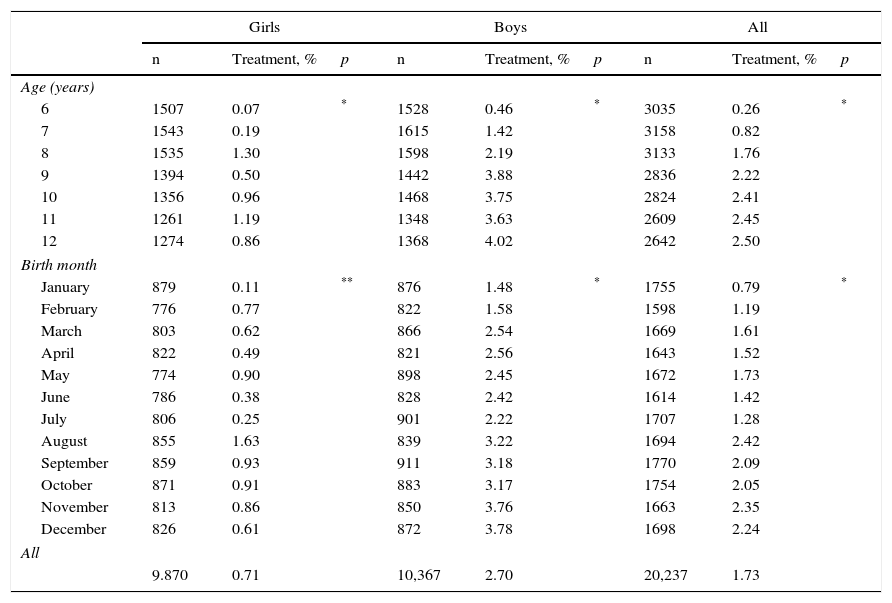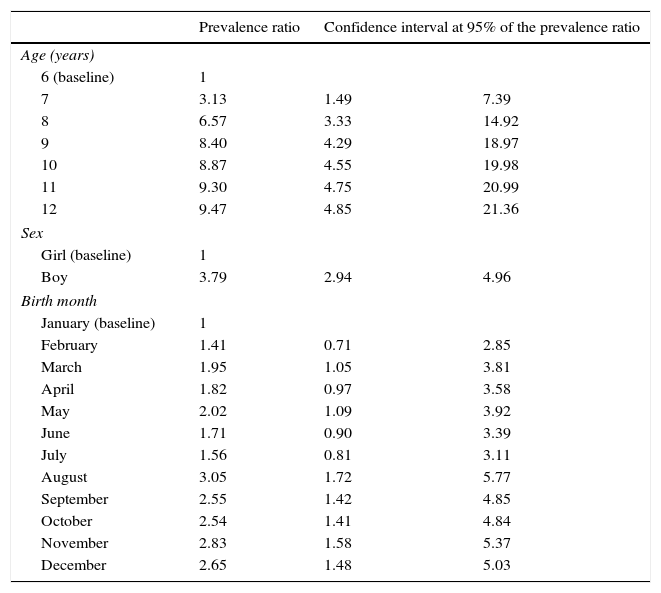Previous studies in various countries have shown that the youngest school children in the same class-grade are more likely to be treated for attention-deficit/hyperactivity disorder (ADHD) than their older classmates. The aim of this study is to determine in the Spanish setting whether younger relative age children in each grade have a higher prevalence of treatment for ADHD.
Subjects and methodsPopulation, observational, cross-sectional study in a health department, using prevalence data (November 2013) of treatment for ADHD in children aged 6–12 years. Data was obtained from the information systems of the Valencia Ministry of Health and multivariate models were used to estimate the prevalence ratio of treatment according to the month of birth of children in each grade.
ResultsTwenty thousand two hundred and thirty-seven children were included of whom 1.73% were treated for ADHD (boys: 2.70%; girls: 0.71%) in October 2013. The prevalence of treatment increased with age, in males, and in youngest children (born in the last months of each year). In the multivariate analysis, the prevalence of treatment in the youngest children (born in the months of August to December) was 2.5–3 times higher than in their older classmates (born in January).
ConclusionsThe younger children relative to their classmates are more likely to be treated pharmacologically with methylphenidate and/or atomoxetine.
Estudios previos en diversos países han mostrado que los niños más jóvenes de su clase tienen una mayor probabilidad de ser tratados por trastorno por déficit de atención/hiperactividad (TDAH) que sus compañeros de clase más mayores. El objetivo de este trabajo es determinar si en nuestro entorno los niños con menor edad relativa en cada curso tienen una mayor prevalencia de tratamientos para el TDAH.
Personas y métodosEstudio poblacional, observacional, transversal, en un departamento de salud, utilizando un corte de prevalencia (noviembre de 2013) de tratamiento para el TDAH en niños de 6 a 12 años. La información se obtuvo de los sistemas de información de la Conselleria de Sanitat y se utilizaron modelos multivariables para estimar la razón de prevalencia de tratamiento según el mes de nacimiento de los niños en cada año.
ResultadosSe incluyeron 20.237 niños, de los que el 1,73% recibían tratamiento para el TDAH (niños: 2,70%; niñas: 0,71%) en octubre de 2013. La prevalencia de tratados se incrementó con la edad, en varones y en los más jóvenes del curso (nacidos en los últimos meses de cada año). En el análisis multivariable la prevalencia de tratamiento en los niños más jóvenes (nacidos en los meses de agosto a diciembre) fue de 2,5 a 3 veces superior a la de los más mayores (nacidos en el mes de enero).
ConclusionesLos niños con menor edad relativa que sus compañeros de clase tienen una mayor probabilidad de ser tratados farmacológicamente con metilfenidato y/o atomoxetina.









